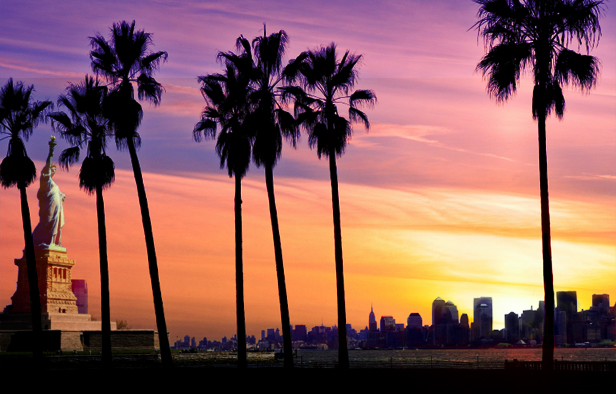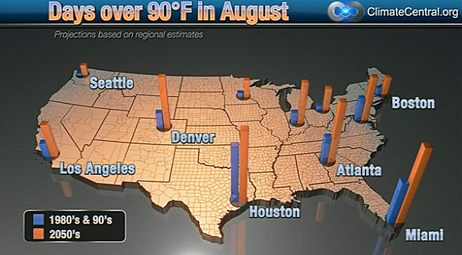In the dog days of August, you can be forgiven for not wanting to think about how it could get hotter, much hotter, in summers to come. Nevertheless, Climate Central, a nonprofit focused on communicating climate science, released a study today forecasting what summers might look like in 21 American cities in 2050.
 Climate Central’s analysis predicts hotter Augusts for many of America’s largest cities by mid-century. More >>The findings are startling, as the study found that even a modest amount of global warming would have a large effect on weather extremes, including extreme heat events. In a sobering set of tables, the group projected that Chicago and New York could experience more extreme heat in August 40 years from now than Atlanta experiences today. The real threat of these heat waves isn’t higher power bills and sweaty armpits; it’s the cascading set of health impacts they would inflict upon the vulnerable populations of American cities.
Climate Central’s analysis predicts hotter Augusts for many of America’s largest cities by mid-century. More >>The findings are startling, as the study found that even a modest amount of global warming would have a large effect on weather extremes, including extreme heat events. In a sobering set of tables, the group projected that Chicago and New York could experience more extreme heat in August 40 years from now than Atlanta experiences today. The real threat of these heat waves isn’t higher power bills and sweaty armpits; it’s the cascading set of health impacts they would inflict upon the vulnerable populations of American cities.
Extreme weather events can wreak havoc upon unprepared populations, such as the Chicago heat wave of 1995 and the 2003 European heat wave, which killed an estimated 40,000 people. These heat waves have proven especially deadly to vulnerable populations, such as the elderly and persons with respiratory illness. Health officials have found themselves besieged in unanticipated extreme weather events, as infants and the elderly succumb to extreme heat or from air pollution exacerbated by high temperatures.
Heat is a catalyst for the formation of smog, which is formed from a toxic soup of volatile organic compounds, tailpipe and smokestack exhaust, and strong sunlight. The lungs of infants, children, and the elderly are by far the most vulnerable to smog inhalation, which can lead to hospitalization and death.
According to a study published in the American Journal of Respiratory and Critical Care Medicine, a 1.8°F increase in maximum temperature corresponded to a 4.5 percent increase in respiratory hospital admissions in 12 European cities. But what does that mean for American cities?
Climate Centrals analysis shows that Denver, in August, would go from an average of seven days a month, above 90°F and one day over 95°F, to a dramatically different climate of twenty-three days a month over 90°F, twelve days a month over 95°F, and three days a month over 100°F. This could lead to massive increases in hospitalizations and rising death rates from those with heart and lung disease, diabetes, or pneumonia.
One factor that can reduce the death rate from extreme weather events, like heat waves, is air conditioning. One reason that the death toll was so high in the Chicago and European heat waves was that the urban populations were unprepared and many of the victims did not have climate control systems. Air conditioning almost certainly would have saved lives in those two events, but it’s a solution that comes with its own costs.
Air conditioning drives peak demand for electricity in most industrialized societies and broader adoption could require the construction of expensive and polluting power plants. Air conditioners are also major drivers, along with black asphalt, of the urban heat island effect. According to the EPA, the annual mean air temperature of a city with 1 million people or more can be 1.8° to 5.4°F warmer than its surroundings. On a clear night, the temperature difference can be as much as 22°F.
In effect, climate control may reduce mortality from direct heat exposure, but could drive more global warming impacts, worsen air quality, and increase urban outdoor temperatures. This is what, in modeling, is called a feedback loop. Finally, increased energy demand could overwhelm the energy grid. A sustained power outage in a 100°F heat wave could be a public health disaster, with apartment buildings, rest homes, and public housing requiring emergency evacuation.
High temperatures affect more than people. Many tree species that are on the margin of a temperature zone will not be able to adjust to the new temperatures and may face catastrophic losses. Sure, tree huggers may be upset, but what does that mean for human health?
Urban tree cover is both a major factor in reducing the urban heat island effect and in scrubbing the air of particulate matter and dust. As natural air conditioners, their loss will increase the impact of the extreme weather events that Climate Central is projecting. The loss of shade trees also can have major impacts on home cooling costs, once again driving up electricity demand. The transition to new species of tree for urban tree cover could leave an entire generation of urban dwellers at increased risk from heat and air pollution. This is another feedback loop showing how the high temperature increases that Climate Central projects can have cascading effects on the human population.
One last impact from these elevated temperatures is on human behavior. Quite simply, there has long been a demonstrated link between elevated temperatures and aggression. The journal Environment and Behavior published research in the mid-eighties demonstrating a linear relationship between heat and horn honking, something anyone who has experienced summer driving can attest to. More recently, a study published in the journal established linkages between assault and high temperatures, with an article, “Global Warming and U.S. Crime Rates,” finding annual temperatures were associated with rates for assault, rape, robbery, burglary, and larceny. So if the heat doesn’t kill you, perhaps somebody else will.
Hot Wheels: Breaking the Cycle
Clearly, a cycle is emerging — one triggered by extreme heat events that continually increases temperatures and the exposure of the human population to dangerous air pollution, behavior, and temperatures. So, what do we do about it?
Global warming activists would say that we should avoid the whole mess by passing a climate bill in the United States and forging a global climate treaty in Copenhagen. However, Climate Central’s analysis is based on one climate model — called A1B by the Intergovernmental Panel on Climate Change. Greenhouse gas emissions have exceeded the A1B scenario this decade, making the projections conservative. So we may be living with their projections, even if we do reduce climate emissions by a considerable amount.
Well, here is the good news, as many of the solutions that will see communities through the tough times to come are known climate change solutions, too. Basically, while Chicago may go from four to fourteen over 90°F days, Mayor Richard Daley’s effort to build the green roof and green space capital of the United States could lower urban temperatures, clean the air, and reduce electricity demand. Solar power produces maximum output during peak cooling demand, meaning the technology’s mainstreaming into the market could alleviate the need for additional power plants.
Finally, energy conservation and passive cooling green buildings can both reduce global warming emissions, the heat island effect, and protect vulnerable inhabitants. The same goes for reducing parking lots and building up mass transit and walkable communities. The solutions to global warming, in this case, can also mitigate its consequences. But green design, renewable energy, and urban planning are not the only solutions we can work on. Eric Klinenberg, in his book on the Chicago heat wave, explored how:
Strong local community and social networks actually can enable vulnerable populations to survive: The urban ecology that interacts with and supports the social fabric. Are the elderly living alone afraid of crime in their neighborhood, or do they feel safe seeking out help at the local grocer? Does the community have access to fast emergency care, or is there a dearth of police, health, or other community services?
So, to break the cycle of heat waves causing a cascading and rising death toll in American cities over the next century, we need to address climate change, but we can do so in a way that builds green space, and clean and healthy communities. We also need to rebuild our social infrastructure so that the elderly, the poor, people of color, and other abandoned populations can survive the coming red-hot American summers.
Madeline Kovacs, a Fired Up Media correspondent, assisted with the research for this piece.



